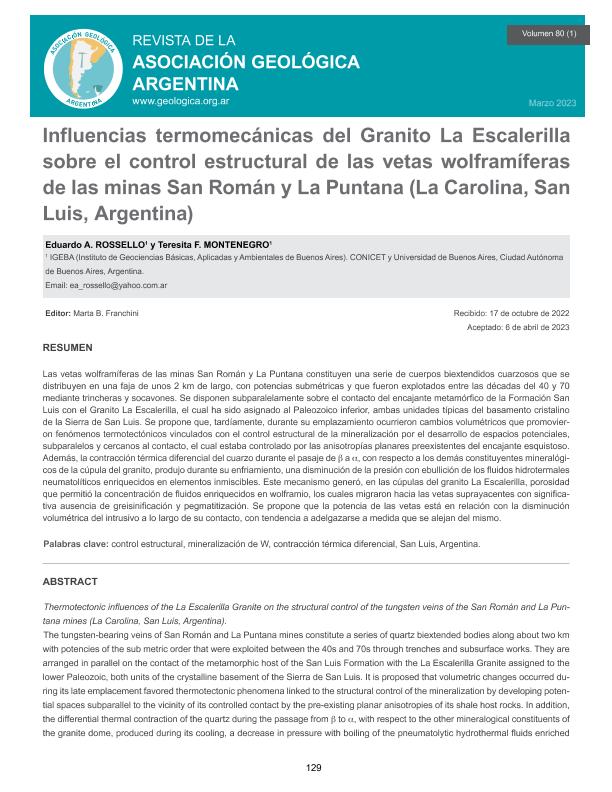Mostrar el registro sencillo del ítem
dc.contributor.author
Rossello, Eduardo Antonio

dc.contributor.author
Montenegro, Teresita Francis

dc.date.available
2024-02-23T14:50:38Z
dc.date.issued
2023-04
dc.identifier.citation
Rossello, Eduardo Antonio; Montenegro, Teresita Francis; Influencias termomecánicas del Granito La Escalerilla sobre el control estructural de las vetas wolframíferas de las minas San Román y La Puntana (La Carolina, San Luis, Argentina); Asociación Geológica Argentina; Revista de la Asociación Geológica Argentina; 80; 1; 4-2023; 129-145
dc.identifier.issn
1853-7138
dc.identifier.uri
http://hdl.handle.net/11336/228192
dc.description.abstract
Las vetas wolframíferas de las minas San Román y La Puntana constituyen una serie de cuerpos biextendidos cuarzosos que se distribuyen en una faja de unos 2 km de largo, con potencias submétricas y que fueron explotados entre las décadas del 40 y 70 mediante trincheras y socavones. Se disponen subparalelamente sobre el contacto del encajante metamórfico de la Formación San Luis con el Granito La Escalerilla, el cual ha sido asignado al Paleozoico inferior, ambas unidades típicas del basamento cristalino de la Sierra de San Luis. Se propone que, tardíamente, durante su emplazamiento ocurrieron cambios volumétricos que promovieron fenómenos termotectónicos vinculados con el control estructural de la mineralización por el desarrollo de espacios potenciales, subparalelos y cercanos al contacto, el cual estaba controlado por las anisotropías planares preexistentes del encajante esquistoso. Además, la contracción térmica diferencial del cuarzo durante el pasaje de a , con respecto a los demás constituyentes mineralógicos de la cúpula del granito, produjo durante su enfriamiento, una disminución de la presión con ebullición de los fluidos hidrotermales neumatolíticos enriquecidos en elementos inmiscibles. Este mecanismo generó, en las cúpulas del granito La Escalerilla, porosidad que permitió la concentración de fluidos enriquecidos en wolframio, los cuales migraron hacia las vetas suprayacentes con significativa ausencia de greisinificación y pegmatitización. Se propone que la potencia de las vetas está en relación con la disminución volumétrica del intrusivo a lo largo de su contacto, con tendencia a adelgazarse a medida que se alejan del mismo.
dc.description.abstract
The tungsten-bearing veins of San Román and La Puntana mines constitute a series of quartz biextended bodies along about two km with potencies of the sub metric order that were exploited between the 40s and 70s through trenches and subsurface works. They are arranged in parallel on the contact of the metamorphic host of the San Luis Formation with the La Escalerilla Granite assigned to the lower Paleozoic, both units of the crystalline basement of the Sierra de San Luis. It is proposed that volumetric changes occurred during its late emplacement favored thermotectonic phenomena linked to the structural control of the mineralization by developing potential spaces subparallel to the vicinity of its controlled contact by the pre-existing planar anisotropies of its shale host rocks. In addition, the differential thermal contraction of the quartz during the passage from β to α, with respect to the other mineralogical constituents of the granite dome, produced during its cooling, a decrease in pressure with boiling of the pneumatolytic hydrothermal fluids enriched in immiscible elements. This mechanism generated in the domes of the La Escalerilla granite porosity and the concentration of fluids enriched in tungsten that migrated towards the overlying veins with a significant absence of greissinification and pegmatization. It is proposed that the thickness of the veins is related to the volumetric decrease of the intrusive throughout its contact and that they tend to thin out as they move away from the contact of the intrusive body.
dc.format
application/pdf
dc.language.iso
spa
dc.publisher
Asociación Geológica Argentina

dc.rights
info:eu-repo/semantics/openAccess
dc.rights.uri
https://creativecommons.org/licenses/by-nc/2.5/ar/
dc.subject
CONTROL ESTRUCTURAL
dc.subject
MINERALIZACION DE WOLFRAMIO
dc.subject
CONTRACCION TERMICA DIFERENCIAL
dc.subject
SAN LUIS
dc.subject.classification
Geociencias multidisciplinaria

dc.subject.classification
Ciencias de la Tierra y relacionadas con el Medio Ambiente

dc.subject.classification
CIENCIAS NATURALES Y EXACTAS

dc.title
Influencias termomecánicas del Granito La Escalerilla sobre el control estructural de las vetas wolframíferas de las minas San Román y La Puntana (La Carolina, San Luis, Argentina)
dc.title
Thermotectonic influences of the La Escalerilla Granite on the structural control of the tungsten veins of the San Román and La Puntana mines (La Carolina, San Luis, Argentina)
dc.type
info:eu-repo/semantics/article
dc.type
info:ar-repo/semantics/artículo
dc.type
info:eu-repo/semantics/publishedVersion
dc.date.updated
2024-02-22T11:17:47Z
dc.identifier.eissn
1851-8249
dc.journal.volume
80
dc.journal.number
1
dc.journal.pagination
129-145
dc.journal.pais
Argentina

dc.journal.ciudad
Buenos Aires
dc.description.fil
Fil: Rossello, Eduardo Antonio. Consejo Nacional de Investigaciones Científicas y Técnicas. Oficina de Coordinación Administrativa Ciudad Universitaria. Instituto de Geociencias Básicas, Aplicadas y Ambientales de Buenos Aires. Universidad de Buenos Aires. Facultad de Ciencias Exactas y Naturales. Instituto de Geociencias Básicas, Aplicadas y Ambientales de Buenos Aires; Argentina
dc.description.fil
Fil: Montenegro, Teresita Francis. Consejo Nacional de Investigaciones Científicas y Técnicas. Oficina de Coordinación Administrativa Ciudad Universitaria. Instituto de Geociencias Básicas, Aplicadas y Ambientales de Buenos Aires. Universidad de Buenos Aires. Facultad de Ciencias Exactas y Naturales. Instituto de Geociencias Básicas, Aplicadas y Ambientales de Buenos Aires; Argentina
dc.journal.title
Revista de la Asociación Geológica Argentina

dc.relation.alternativeid
info:eu-repo/semantics/altIdentifier/url/https://revista.geologica.org.ar/raga/article/view/1667
Archivos asociados
